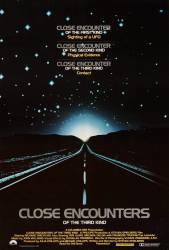Continuity mistake: When Roy first encounters the alien ship at the railroad crossing, when the bright light comes on, he leans out of the truck window, and the right side of his face is exposed to the light. Therefore, it is the right side of his face that should have been burned. Subsequent shots show that the left side of his face is burned. (00:21:00)
Suggested correction: Roy shields the right side of his face with the hand holding the torch so that it's not exposed. His left side is not covered so it gets burnt.
How could the left side of his face get burned, if it's not exposed to the light?.
Continuity mistake: When Richard Dreyfus has his first UFO encounter at the railway crossing, all the gauges in his truck go wild and the contents of the glove box comes flying out. After the encounter finishes, and the vehicle's power comes back, Dreyfus starts the engine and drives off. Miraculously, the interior of the truck has tidied itself and restored the glove box contents to their proper place. (00:21:30)
Continuity mistake: The film starts in Muncie Indiana. There is a scene in the hills near the town. There are NO hills near Muncie, it's flat as a board. (00:24:30)
Continuity mistake: When Roy says to Ronnie, "I saw something last night that I can't explain.," and he bridges his arms across the door frame his forearms are parallel to the ground. In the following shot, when Ronnie straightens up, Roy's forearm points upward. (00:36:15)
Continuity mistake: As the mom and her son run into the kitchen of their house for safety the appliances start to shake. In the first scene with the stove, all of the pans are shaken off the top, but when they come back for a close up there are pans back on top. (00:56:00 - 00:57:00)
Continuity mistake: After Roy fills their kitchen with shrubs, bricks, soil, and chicken wire, Ronnie takes their three kids out of the house and into their station wagon. She tells her kids to lock the doors, but the driver's side door lock is up (unlocked). When Roy walks around the driver's side to speak with Ronnie, the driver's side door lock is now down (locked). (01:10:05)
Continuity mistake: When Richard Dreyfuss is building the model of the Devil's Tower in his living room, behind him in the sliding glass doors you can see that it is raining, and when he turns around and walks to the door to look out, it is now sunny, and people are out side mowing the grass and children playing. (01:15:40)
Continuity mistake: When Ray first arrives at Devil's Tower and stops the station wagon, the broken fence post resting on the hood changes positions between shots. In the view of him through the wind shield, the post is lying straight, parallel to the length of the wagon. In the next shot, it is suddenly at an angle, even though the car hasn't moved. (01:21:30)
Continuity mistake: During the scene at the landing site the number of people on the landing pad varies dramatically from shot to shot.
Continuity mistake: Before Roy takes the top of the clay-mountain off, the model has smooth sides. When he is about to tear it, it swaps to striped sides.
Continuity mistake: Jillian's hair keeps swapping from messy to brushed and back to messy during her climbing down the rock and after hugging her son.
Continuity mistake: In Jillian's home, after the record player starts to play, she holds Barry against her right shoulder. A frame later he's on her left shoulder.
Continuity mistake: The morning Roy sees Devil's Tower on the TV, the beer on top suddenly disappears.
Continuity mistake: While Roy watches Barry make the mud mountain, its top is flat, but a frame later it's taller and peaked.
Continuity mistake: After Roy makes a mountain with the mashed potato, the bowl has food coming out. Two seconds later, after Roy talks to his family, the food is gone, despite no one having touched the bowl.
Continuity mistake: Roy is stalled in his truck at the railroad track. We see the mailboxes behind him burst open and all the mail comes flying out. Next shot, from inside the truck, the mailboxes are closed. Then another outside view shows them open again.
Continuity mistake: In the alien departure scene at the very end of the film, a solitary alien exits the mothership and approaches Francois Truffaut, who extends his right hand directly towards the alien and makes the Five Tones hand gesture. The camera cuts to another angle half-way through the gesture, and we see that Truffaut is now looking sharply to his right, over his extended arm, and smiling broadly at the alien as he completes the hand gesture. Apparently, Truffaut's body and extended arm pivoted 90° away from the alien mid-way through the 2-second gesture.
Continuity mistake: While Roy and a crowd are gathering on the side of the road waiting for the aliens, a group of old men play cards on a table packed with food and drinks. When the angle changes (when Jillian meets Roy) one of the men has vanished and the table is empty.
Continuity mistake: In Sonora, a man introduces himself as a cartographer and walks 5 meters away from a crowd. When the angle changes he's barely half a meter away from the crowd.
Continuity mistake: While being blinded by the UFO, Roy grabs his flashlight from the round part next to the ligh bulb. Half a second later he is grabbing it from several centimeters below.





